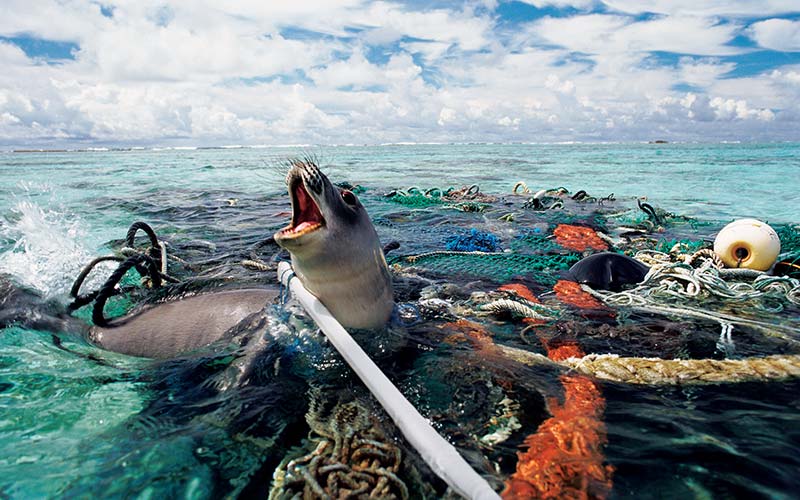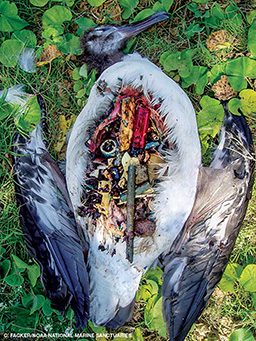On a dive over reefs near Ambergris Caye, Belize, a few years ago, I snagged a napkin-sized piece of drifting plastic and tucked it into my BC pocket. A few minutes later I noticed a smaller piece and plucked it up, too. Before the dive ended I had collected half a dozen bits of plastic.
This prevalence of plastic was disappointing, but I was soon dismayed to learn that Belize is far from the worst offender.
A recent study by a group at the National Center for Ecological Analysis and Synthesis found that 20 of the world’s nearly 200 countries with coastlines account for 83 percent of the total volume of plastic that washes into the sea — an amount that researchers estimate to be between 4.8 and 12.7 million metric tons each year. That’s at least at least 10 billion pounds of plastic.
To put this in perspective, Jenna Jambeck, the principal author of the study, explained that the volume of plastic entering the oceans each year is equivalent to five grocery bags filled with plastic for each foot of coastline in the world — and that includes only municipal waste. When we consider other types of waste as well, we discard a total of some 275 million metric tons (606 billion pounds) of plastic each year.
“Until now, what we knew about plastic in the ocean was from observations at sea,” said Kara Lavender Law of the Sea Education Association, one of the study’s authors. “That only accounts for a fraction, though, since only certain plastics float. The difference with this work is that we were looking at the flow coming from land.”
Plastic debris is unsightly for divers and others who enjoy the oceans, but more important, it threatens marine life. Scientists at Plymouth University in England documented encounters between 693 marine species and manmade debris; 92 percent of these involved plastic. The encounters included entanglement, ingestion, direct damage to the ecosystem (such as coral or seagrass destruction) and rafting, in which debris literally picks up and moves an animal. Plastic rope and netting cause most entanglements, which particularly affect northern right whales and green, loggerhead and hawksbill sea turtles. The Project Aware Foundation reports that an estimated 50,000 to 90,000 northern fur seals die each year entangled in marine debris. Nearly 80 percent of the entanglements observed in the Plymouth study harmed or killed the animal.
Green sea turtles, California sea lions and Atlantic puffins are some of the species known to ingest plastic fragments. According to one study cited by Project Aware, 95 percent of dead, beached northern fulmar birds had plastic in their stomachs, and a North Pacific Central Gyre study found that 35 percent of plankton-eating fish had ingested plastic. Australian researchers found that Great Barrier Reef corals will eat microplastic (the bits of plastic left when larger items break down), consuming almost as much plastic as they do marine plankton.

A Solvable Problem
Theoretically, plastic debris is a solvable problem. “If we increase waste management to 100 percent coverage in the top 10 countries and cap our waste generation and the percentage of it that is plastic,” Jambeck said, “we could stop 77 percent of the input by 2025.” Halving the amount from the top 20 countries would reduce the total amount of plastic reaching the sea by almost 40 percent.
Law said the authors were initially hesitant to publish a ranking of countries. “But I’ve heard people say they are happy someone is noticing this problem and are optimistic about the prospect of people being motivated to act,” she explained. “We’re hopeful this will result in a first step toward international-scale solutions.”
In developed countries, improving waste management offers less of a benefit: “The U.S. does a pretty good job and yet is still number 20,” Law said. Capturing more plastic in the recycling stream also offers limited benefit, as only a few types have real market value. Ultimately, she said, we must reduce the amount of plastic produced. “We use a valuable resource — oil — to produce a material designed to be strong and durable but then use it to make many things that we need for only a few minutes,” she said. And virtually every piece of plastic ever made still exists today.

Both Jambeck and Law emphasize that individual choices make a difference, and the more people willing to make changes, the bigger the difference. “Carry your own reusable water bottles and bags, buy less packaging, and pick up what you see when diving or on the beach,” Law suggested. “Talk to dive operators. Point out that the industry depends on the ocean environment and say, ‘What about not using disposable water bottles?'”
Even something as simple as a proper trash receptacle on a dive boat to keep trash out of the water is a fine start. “Everyone can play a role in mitigating the ocean plastic problem,” said Nicholas Mallos of Ocean Conservancy. “Be aware of your own plastic use, and ensure that your trash, on land and water, is disposed of properly.”
Divers can also take part in several initiatives to remove plastic already in the ocean. Project AWARE encourages divers to collect debris through its Dive Against Debris program and recently launched a specialty certification to help train divers to be debris-fighting citizen scientists.
The Ocean Conservancy sponsors an annual International Coastal Cleanup (ICC), a worldwide volunteer effort to clean waterways and the ocean. While many volunteers work on beaches and shorelines, some work underwater. “Divers play an integral role in the ICC and Dive Against Debris, collecting debris that’s already made its way into the marine ecosystem,” Mallos explained.
Dive groups can also organize underwater cleanups with guidance from the Ocean Conservancy’s Do-It-Yourself Cleanup Tool Kit site.
Defining a problem is the first step toward solving it. Now that we see the astonishing quantity of litter and poorly managed waste ending up in the ocean, perhaps we’ll be inspired to make changes. Meanwhile, I’ll continue nabbing those bits of plastic that intrude on my dives.
Reference
Jambeck JR, et al. Plastic waste inputs from land into the ocean. Science 2015; 347(6223):768–771; doi:10.1126/science.1260352.
Explore More
© Alert Diver — Q3 Summer 2015